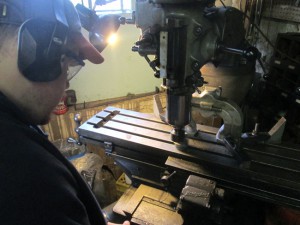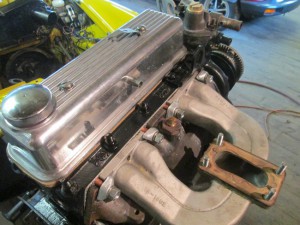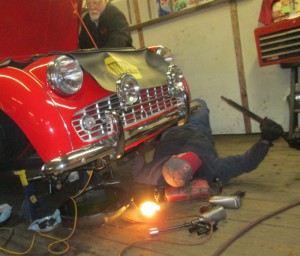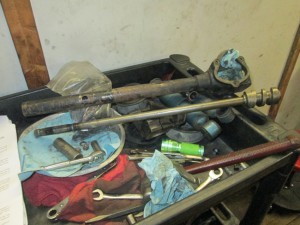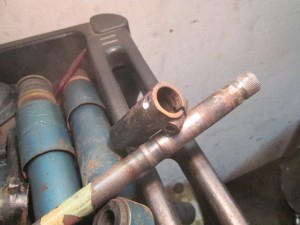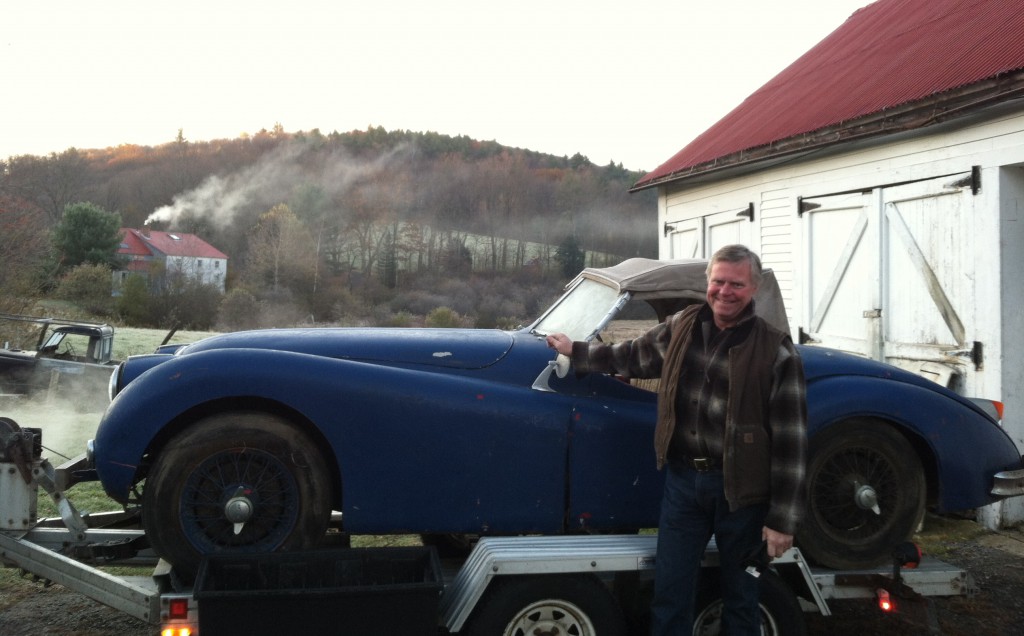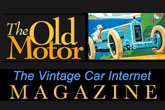The Zenith Stromberg carburetor was the British Leyland Motor Corporation carburetor of choice for obtaining emissions compliance in the 1970’s, and when properly maintained, they worked pretty well. However these days it’s pretty rare to still see them, at least on Midgets & MGB’s, where by and large they have been replaced by Weber carburetors. The Weber is an instrument with a large tuning capability, especially in side draft configuration, and there is also a healthy aftermarket for the manufacture of manifolds to adapt them to a given engine. As for whether some of these manifolds are themselves enhancements, is open to conjecture around here. Sometimes they can turn out to be very much “trim to fit”.
The intake manifold on the yellow Midget 1500 seen here last week is a case in point, it was about 1/16″ thicker than the exhaust manifold and when John pulled them off, the manifold studs were all bent about 15 degrees in the attempt to take up the gap. But there is a better way, and while you can make a perfectly servicable alteration with a die grinder, the more elegant approach is to machine it on the vertical mill. Unfortunately, the only tool we had which could reach underneath the downward sloping casting was the boring bar which only had contact with the flange surface for about 45 degrees of its arc, what we call an interrupted cut. Click on the 2nd picture for a closer look.
Actually, the main event this week has been Butch’s continuing efforts in installing a complete Revinton TR suspension kit in the red TR3 seen here. You may have heard the expression: Red paint hides a multitiude of sins. This TR3, which was shipped up from New Orleans by one of our favorite customers, was very sinful.
To pull the steering box out of most Triumphs, removal of the front nose panel is the usual first step, but we caught a break with this car because
it was equipped with a steering box with what is known as a “split” steering column, whereby the upper and lower parts of the column are joined by a coupler that pinches up the splined ends of the upper and lower shafts.
Visible in the back of Butch’s work cart is the steering box, and you can see the fill hole in the column housing just over a plastic zip bag. In front of it is the column with the steering worm. Normally 90 weight gear lube is the lubricant, although this one was packed with grease
instead, which wasn’t a good sign.
I mentioned previously that the coupler is splined to the upper & lower shafts and retained by pinch bolts, but Butch had the Devil’s work to separate them because sometime in the past, the lower pinchbolt had gone missing, and the steering forces on the now-relaxed lower coupling had damaged the splines.
In a truly classic example of shockingly bad judgment, instead of replacing the pinch bolt, the repairer of the moment drilled & tapped the opposite side of the coupling, threaded it and ran in a screw & broke the head off !
Click on the picture and you can see the contact area from the screw in the damaged splines on the column. How many years has this been all that stood between the driver and certain death ??
In other news, you may have noticed the appearance of a new ‘web tile’ to the right of this commentary. Wray Schelin is a panel beater of the first order, and is the go-to guy in the East for XK Jaguar metal work. These days Wray is also teaching his craft to all comers and has regular monthly classes for those interested in learning metal shaping.
Earlier this fall I decided that it was time to get on with it, and start putting my XK 140 MC roadster together. Although it was sold new by Pries Motors of Hayward, California late in 1955, it spent a number of years bumping into things in and around Shelburne Falls, Massachusetts before I acquired it.
While I don’t anticipate that it will be an inexpensive undertaking, I didn’t feel the need to pay someone else’s tuition to learn on the car, either. Wray has spent many years working with these cars and has built the fixtures and the panel bucks that are necessary to accurately replace their damaged sheetmetal. I’m pumped.
Look for periodic updates as things move along.

